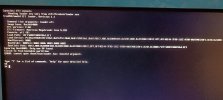Pretty much what the title says. I do have a USB (sdc). I created two partitions. The first one (sdc1) is formatted to ext4 and the second one (sdc2), I let it be used as the partition to create bootable images. I had the idea, literally right now after Ventoy failed to boot FreeBSD (14.0), and after I searched on the internet that this is possible (tho, no instructions on how to do it, so I simply figured it out myself). I "burned" the FreeBSD ISO, using the instructions shown in the Handbook, using dd and sdc2 as the option of "of".
Now, I am able to boot using the second USB partition, but FreeBSD shows the output in the image I have attacked. Isn't that possible with FreeBSD or I did something wrong? Anyone else was able to achieve what I tried? Thanks for the help, and let me know if you need more information to be provided!
Now, I am able to boot using the second USB partition, but FreeBSD shows the output in the image I have attacked. Isn't that possible with FreeBSD or I did something wrong? Anyone else was able to achieve what I tried? Thanks for the help, and let me know if you need more information to be provided!


